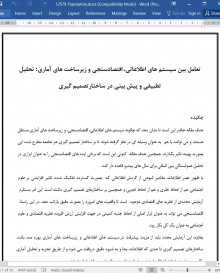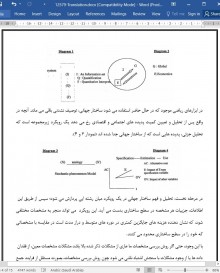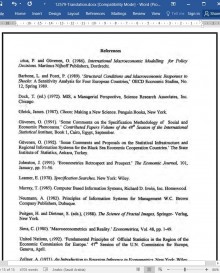
دانلود مقاله تعامل بین سیستم های اطلاعاتی، اقتصادسنجی و زیرساخت های آماری
چکیده
هدف مقاله حاضر این است تا نشان دهد كه چگونه سیستم های اطلاعاتی، اقتصادسنجی، و زیرساخت های آماری مستقل هستند و می توانند با هم به عنوان وسيله اي در نظر گرفته شوند تا بر ساختار تصمیم گیری هر جامعه مطرح شده ایی بصورت بهینه تاثیر بگذارند. همچنين هدف مقاله کنونی این است که برخی ایده های اقتصادسنجی را به عنوان ابزاری در تحلیل هموابستگی بين المللي برای سال هاى پیشرو قاعده دار کند.
با ظهور عصر اطلاعات، مقادير انبوهی از گردش اطلاعاتی که بصورت گسترده تفکیک شده، تاثیر افزایشی بر علوم اجتماعى هم از لحاظ نظري و هم از لحاظ تجربی و همچنین بر ساختارهاى تصميم گيرى داشته است. اين امر مستلزم آزمایش مجددی از نظريه هاي اقتصادي موجود است تا واقعيت های امروزه را بصورت دقیق بازتاب دهد. در اين راستا، اقتصادسنجی می تواند به عنوان ابزار اصلی از لحاظ جنبه كميتی در جهت افزايش ارزش افزوده نظريه اقتصادي و علوم اجتماعي به عنوان يك كل بکار رود.
بعلاوه، اين آزمایش مجدد بايد از مزیت پيشرفت در سیستم های اطلاعاتی و زیرساخت های آماری بهره مند باشد. ساختارهاي تصمیم گیری تا حدی که اطلاعات، بجا و به شيوه دقیق دریافت می شود و از طريق تجزيه و تحليل آماری بکار می روند، در تحقق اهداف خود در محيط جهانی در حال تغییر موفق خواهند شد.
در خاتمه، اين مقاله تنظیم شده تا نشان دهد که شدت گردش اطلاعات و بهبود فنون کمیت سازی تاثیر بسزایی بر علوم اجتماعی خواهد گذاشت. علاوه بر اين، به دليل ارتباط قوي ميان جنبه هاي نظري و تجربي علوم اجتماعي، يك بازبینی مطابقی با این جنبه نظری علوم اجتماعي وجود خواهد داشت. این امر ضروری خواهد بود چرا که گردش جدید اطلاعات تفکیک شده و استفاده گسترده ازفنون کمیت سازی و پردازش داده ها با کمک فن آوری اطلاعات، نظریه هاي موجود را بصورت ناکافی تعبیر می کند. قاعده سازی مجدد نظریه ها، بر اساس افزايش اطلاعات موجود و بر اساس رویکرد میان رشته ایی خواهد بود. این امر مستلزم اصلاح فنون کمیت سازی و نظریه های موجود است.
1. مقدمه
از چند دهه گذشته، جهان پديده ازدیاد اطلاعات با میزان افزایشی را تجربه کرده است. بدين ترتيب، اين دوران بطور مناسب «عصر اطلاعات» نامیده می شود و این سیستم جهانی بخاطر اهمیت آن از لحاظ تاثیر خود بر کل modus operendi به انقلاب صنعتی شبیه شده است.
چالش حاضر این است، چگونه سیستم های اطلاعاتی را طراحی و استفاده کنیم كه بتواند در دسترس پذیری اطلاعات را بطور مناسب و موثر به نحوي بهینه کند تا تاثير مناسبي بر ساختار تصمیم گیری سياست گذاران بگذارد. موثرترين وسيله براي انجام چنین کاری، از طريق هماهنگی گسترده اقتصادسنجی، سیستم های اطلاعاتی، و زیرساخت های آماری حاصل می شود.
مانند هر مرحله از پيشرفت تكنولوژيکی که برگشت تغییر ، در سرتاسر سیستم جهانی بجلو سوق می یابد مدل های موجود ایستا برای نصب و دسترسی به سیستم های اطلاعاتی که به تصميم گيرندگان این اجازه را می دهد تا جایگزین های خود را بدانند و تصميمات بروز شده ایی از اطلاعات بگیرند ناکافی هستند.
هدف این مقاله بررسی تعامل بین سیستم های اطلاعاتی، اقتصادسنجی و زیرساخت های آماری و نشان دادن الزام آزمایش بیشتر بر اين تعامل است تا اینکه یک مدل پویایی از پردازش، تحلیل، و در دسترس پذیری اطلاعات ایجاد شود. هدف نهايي، ایجاد هماهنگي بهینه از اجزای فوق الذکر است تا تصميم گيرندگان بتوانند به نفع همه كشورها، نهادها، و افراد درون اين سیستم، بطور کارامد در سیستم جهانی عمل کنند.
هدف اين مقاله همچنين قاعده دار کردن ایده هایی در اقتصادسنجی برای سال هاى پیش رو است تا به عنوان ابزاری برای تحلیل هموابستگی بين المللي باشد. سرانجام، هدف اضافی مقاله کنونی این است که نشان دهد چقدر نظريه هاي موجود بخاطر گردش زیاد اطلاعات تفکیک شده و استفاده گسترده از تکنیک های کمیت سازی و پردازش داده ها با کمک فن آوری اطلاعات، بطور ناکافی تعبیر خواهند شد. این امر مستلزم اصلاح نظريه های موجود و فنون کمیت سازی در علوم اجتماعي خواهد بود.
5. نتیجه گیری
جاییکه اقتصادهای محلی و ملی به طور فزاینده هموابسته هستند، ولی چون جهان در حال ورود به عصر جهانی شدن است فرایند اقتصادی، تکنولوژیکی، و اجتماعی به سرعت از مرزهای منطقه ای و ملی عبور می کند. این امر برای هر کشور الزامی می شود تا منافع خود را با دیگر کشورها متناسب کند تا اطلاعات بروز شده ایی در مورد آخرین تحولات و پیشرفت ها داشته باشد.
جهاني شدن سریع در حال وقوع است، زيرا عنصر جديدي در سيستم جهاني يعني گردش اطلاعات تفکیک شده با سطوح بي سابقه معرفی شده است. به همین دلیل یک سیستم کاملا جدیدی از متغیرهای توضیحی وجود دارد. این بدان معنی است که تغییر سریعی در هر دو نظریه اقتصادی و تکنیک های سنجش تعیین کمیت وجود دارد که به این ترتیب متحمل تحولی در این زمینه ها خواهد شد. با توجه به علوم اجتماعی، تأثیر ممکن است تعامل بین ساختار جهانی و "E" و همچنین دیگر علوم اجتماعی را توضیح دهد.
ABSTRACT
The aim of this paper is to show how econometOcs, infonnation systems, and statistical infrastructures are independent, and can be viewed together as a means to optimally impact the decisional structure in any given society. This paper also aims to fonnulate some ideas on econometrics towards the coming years as a tool for analyzing international interdependency .
Wrth the advent of the information age, tremendous amounts of highly disaggregated information flows have had an increased influence over the social sciences both theoretically and empirically, as well as over the decision making structures.This necessitates a reexamination of the existing economic theories in order to accurately reflect today's realities. In this sense, econometrics can be used as the primary tool in terms of the quantitative aspect for increasing the value added to economic theory and the social sciences as a whole.
Additionally, this reexamination should take advantage of the advances in information systems and in statistical infrastructures . To the extent that information is received in a timely and thorough manner, and is utilized through statistical analysis, decisional structures will succeed in achieving their targets in a rapidly changing world environment.
In conclusion, this paper sets out to show that the intense flow of information and the improvement in quantification tecbIDques will have a strong impact on the social sciences. Furthermore, there will be a corresponding revision of the theoretical aspect of the social sciences doe to the strong link between the empirical and theoretical aspects of the social sciences. 1bis will be essential because the large new flows of disaggregated informatjon and wide use of quantification techniques and data processing, assisted by information technology, will render the existing theories insufficient. The reformulation of the theories will be based on the increased information available, and will be based on an interdisciplinary approach. This will necessitate the reform of the existing theories and quantification techniques.
1. lntroduction
Over the past few decades, the world has been experiencing a phenomenon which has seen the proliferation of information at exponential rates. Thus, this era has been appropriately tetmed the "information age", and bas been liken.eel in its significance to the Industrial Revolution in terms of its impact on the entire modus operendi of the global system.
The challenge at hand is how to utilize or design information systems that will appropriately and efficiently optimize the availability of information in a manrter that will most favorably impact the decisional structure of policy makers. The most effective means for doing so is through the eideosive coordination of econometrics, information systems, and statistical infrastructw-es .
As each phase of technological advancement propels the reverberations of change throughout the global system, the existing static models for installing and accessing information systems, which allow decision makers to know their alternatives and to make decis_ions on the most up to dateinformation, become insufficient.
The aim of this paper is to review the interaction between econometrics, infoanation systems, and statistical infrastructures and to demonstrate the need for further examination of this .interaction so as to create a dynamic model of information processing, analyzing and accessibility . The ultimate goal is to produce an optimal coordination of the aforementioned components so that decision makers can function most productively in the global system to the benefit of all the countries, institutions, and individuals within this system.
This paper also aims to formulate some ideas on econometrics towards the coming years as a tool for analyzing international interdependency. FinaUy, one additional aim of this paper is to demonstrate how the existing theories will be rendered insufficient due to the large flows of disaggregated information and the wide use of quantification techniques and data processing, assisted by information technology. This will necessitate the reform of the existing theories and quantification techniques in the social sciences.
5.Conclusion
Because the world is entering an era of globalization, where local and national economies are becoming increasingly interdependent, economic, technological, and social trends are quicldy transcending regional and national boundaries. This makes it imperative for each country to harmonize its interests with others to have updated information on the latest developments and advances.
Globalization is occuni.ng vuy rapidly primarily because a new element in the global system bas been introduced, namely disaggregated information flows at unprecedented levels. There is also an entirely new system of explanatory variables because of this. This implies that there will be rapid change in both economic theory and quantification techniques which will thereby incur a transformation in these areas. With respect to the social sciences, the impact will be possible to explain the interaction between the globa1 structure and the "E" as well as other social sciences.
چکیده
1. مقدمه
2. نظریه هایی در مورد روش بررسی مشخصات پدیده های اقتصادی و اجتماعی
3. ارتباط بین نظريه اقتصادي، نظريه اطلاعات، اقتصادسنجی ، سیستم های اطلاعاتی و زیرساخت های آماری
3.1. نظریه اطلاعات
3.2. نظریه اقتصادسنجی و اقتصادی
3.3. سیستم های اطلاعات
3.4. زیرساخت های آماری
4. هموابستگي ميان ساختارهاي اطلاعاتي و ساختارهاي تصميم گيرى
5. نتیجه گیری
منابع
Abstract
1. Introduction
2. some comments on the specification methodology of social and economic phenomena
3. The link between economic theory, information theory, econometrics, information systems and statistical infrastructure
3.1. Information theory
3.2. Econometric and economic theory
3.3. Information systems
3.4. Statistical infrastructure
4. The interdependence between information structures and decision making structures
5. Conclusion
References
- اصل مقاله انگلیسی با فرمت ورد (word) با قابلیت ویرایش
- ترجمه فارسی مقاله با فرمت ورد (word) با قابلیت ویرایش، بدون آرم سایت ای ترجمه
- ترجمه فارسی مقاله با فرمت pdf، بدون آرم سایت ای ترجمه



